If you’ve got adventurous kids that love a good physical challenge, give indoor rock climbing a try! There are so many amazing benefits of rock climbing for kids, including improved coordination, physical strength, problem-solving, gross motor skills, and communication. And it’s easier to get started than you might think! There’s very little required gear, and you can learn everything you need to get started rock climbing at your local rock climbing gym. Today, Michelle Garrett, California mom and founder of Wonder Club Explorers, is here sharing her recent climbing experience and what they learned. Climb on!
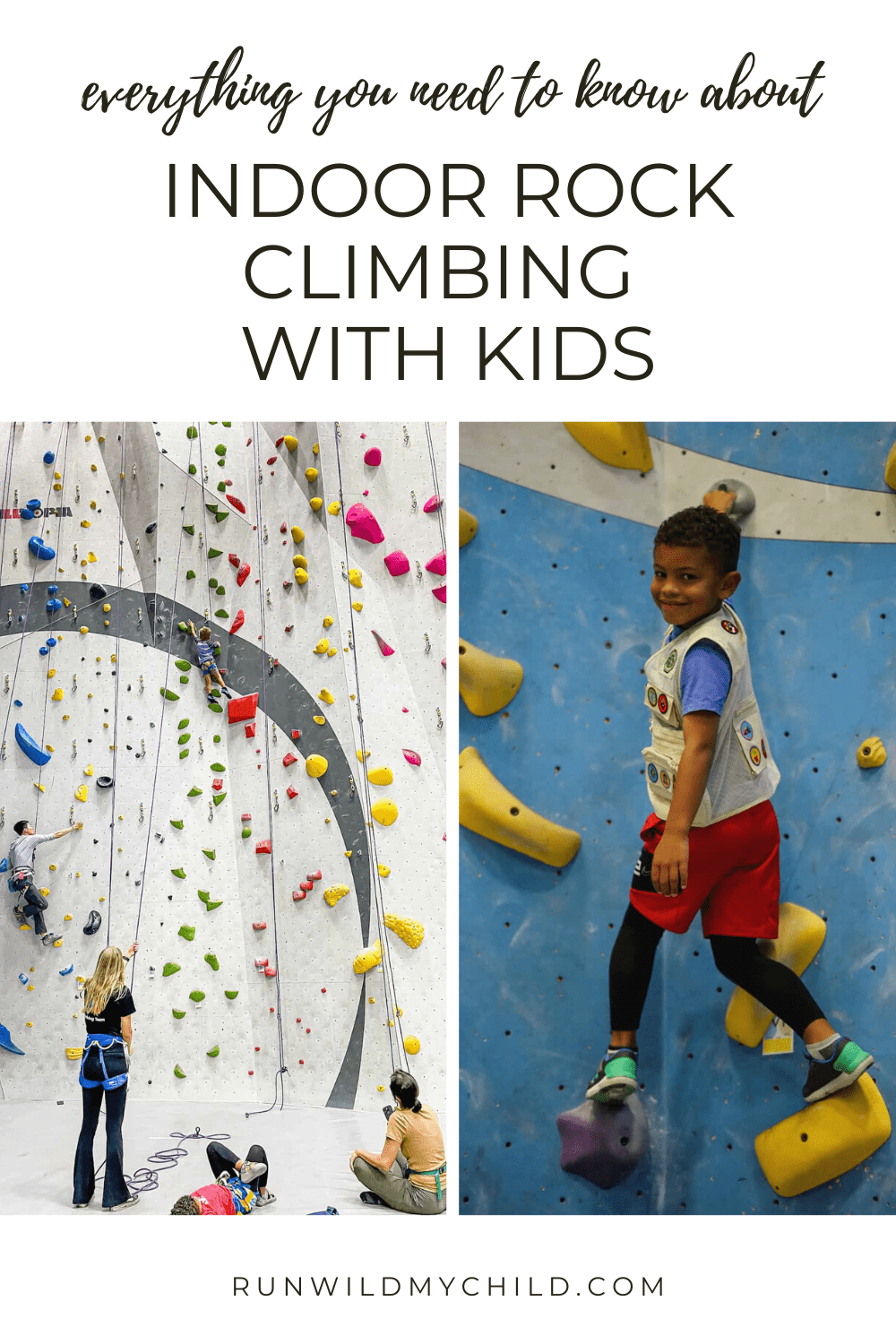
When the kids are climbing the walls
Stop me if this scenario sounds all too familiar…it’s the middle of the day. The kids are tired of their usual play. They are starting to argue and fuss about being bored. There’s nothing to do at home. They’re full of energy. They are climbing the walls!
Well, the next time you find yourself searching for fun alternatives to climbing the walls, why not just let them climb the walls with indoor rock climbing?
Checking out our local climbing gym
We recently had the opportunity to visit Sender One, an indoor rock-climbing gym in Los Angeles, California. From the moment we entered, we were welcomed into a supportive environment full of indoor climbing walls and friendly faces. This was such a great place to get started and learn the ropes from experienced instructors on a wide variety of climbing structures. There was even a special room full of rock walls and climbing structures just for kids. During our visit, we talked to indoor rock-climbing enthusiasts, experienced staff members, and instructors, all of which shared their best tips for indoor rock climbing with kids, which we’re passing on to you today!
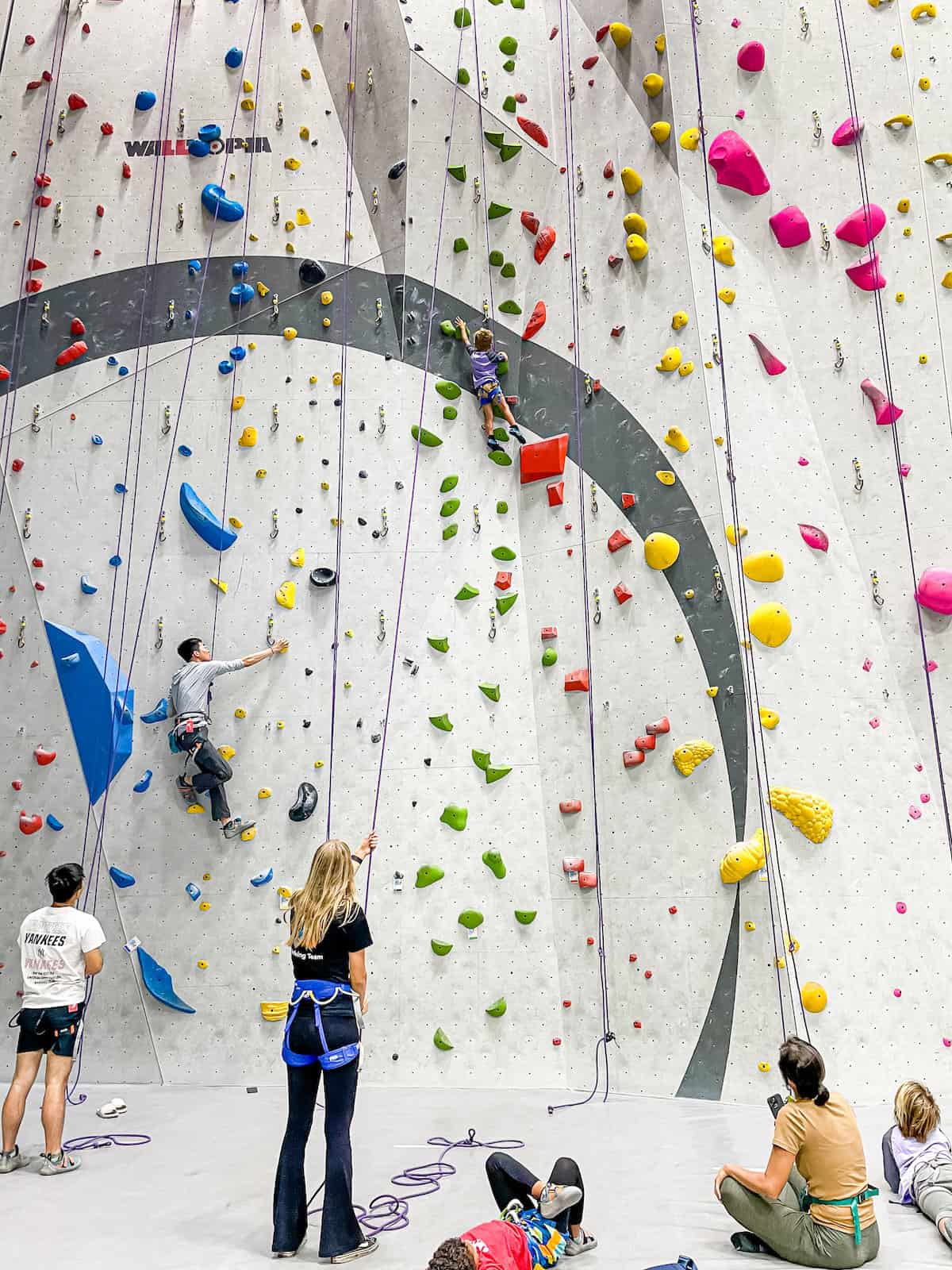
Benefits of indoor rock climbing for kids
The benefits of indoor rock climbing for kids are huge! In just one session at Sender One, my son’s climbing confidence skyrocketed. By the end of the session, he asked not only to return again but to attempt bouldering (climbing without ropes) as well.
Coordination, especially awareness of hand-eye-foot movements, is put to the test when indoor rock climbing. As kids reach for holds, place feet, and maneuver up and down climbing walls, it forces them to pay attention to their body awareness and focus on the task at hand. This focus helps to build problem-solving skills so they can navigate routes and figure their own way out when stuck.
Of course, indoor rock-climbing gyms are supportive environments, so young children also learn how to communicate and listen, especially when given instructions from their climbing partner.
Kids get quite the workout while rock climbing. They use a variety of muscle groups, build strength, and engage in physical fitness when climbing. Kids might not immediately recognize the physicality of rock climbing, but after a few climbs up and down an indoor climbing wall, they might be slightly out of breath and in need of water! While group sports are not for everyone, rest assured that indoor rock climbing is considered a sport- an Olympic sport!
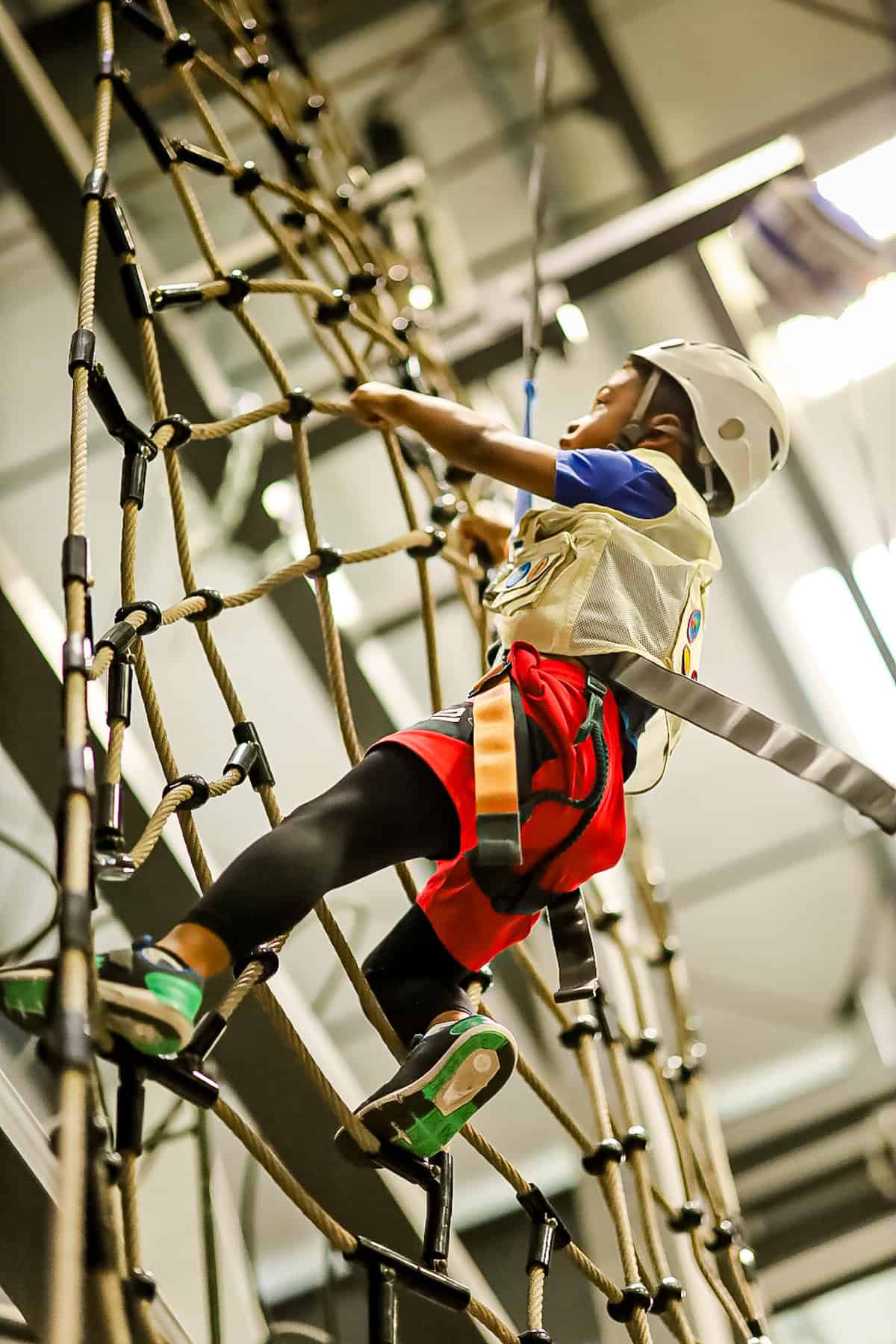
Bouldering vs. rope climbing
We quickly learned that there are two main types of indoor rock climbing. There’s bouldering, which is free climbing without the assistance of a rope belay or harness. In a bouldering session, participants climb indoor climbing walls or bouldering walls with color-coded grips and footholds of all shapes and sizes. Using their own strength, climbers ascend or descend a wall using their grip and muscles to maneuver around the climbing wall.
Similarly, rope climbing has color-coded rock grips and footholds on an indoor climbing wall. Unlike bouldering, climbers benefit from the assistance of a harness, a rope belay system, and a climbing partner to facilitate the belay action from the ground. The harness and rope belay allows the climber to climb higher with a sense of security from their climbing partner operating the belay. Some climbing gyms have auto-belay climbing routes. This means there is a mechanical rope and pulley system to provide tension so one can climb without the assistance of a partner.
When it comes to indoor rock climbing for kids, both bouldering and rope climbing are equally fun. Each type of climb offers its own unique benefits and challenges that will appeal to kids in different ways. During our first time visit to Sender One, we tried both bouldering and rope climbing. No surprise here, but the kids loved both!
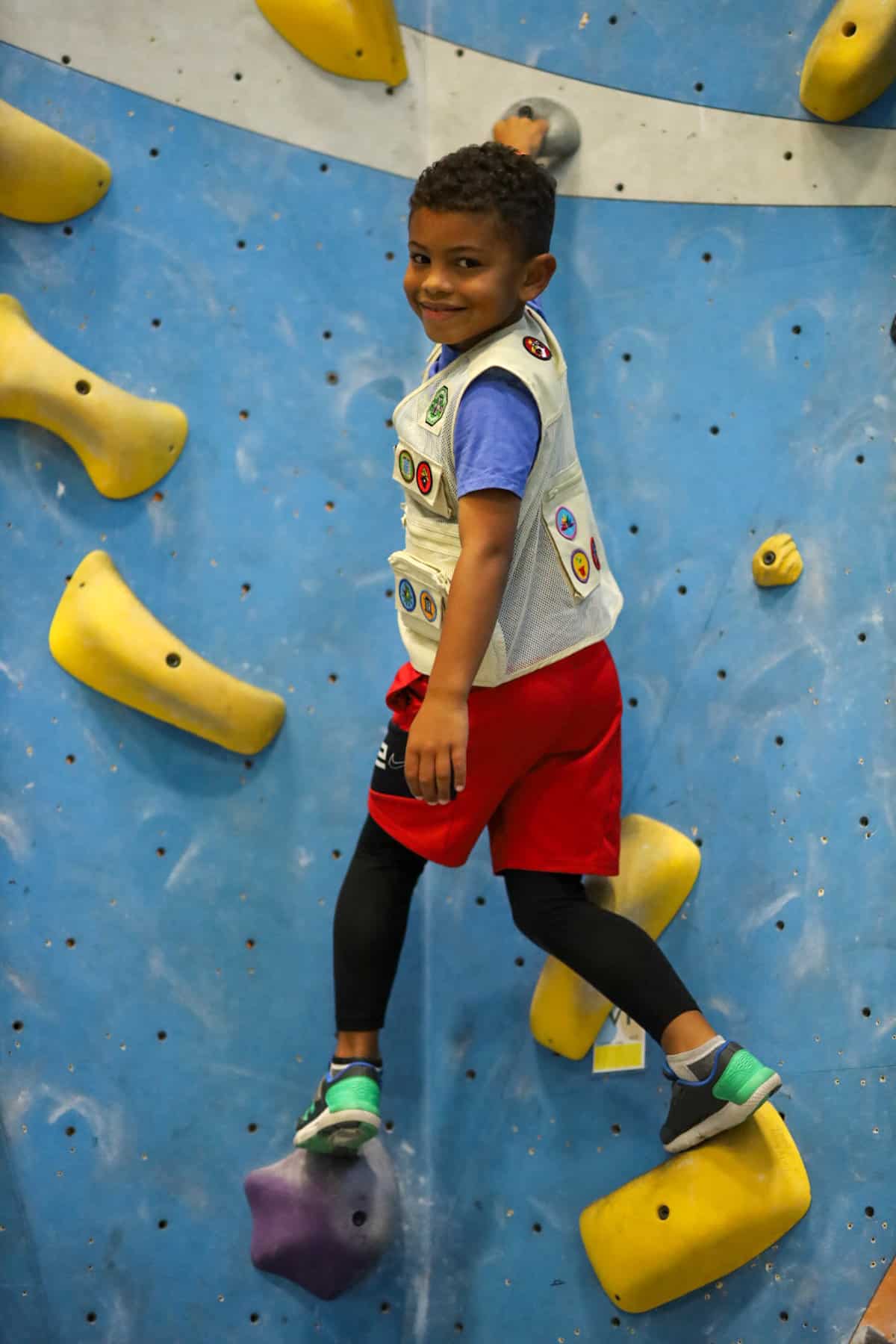
When to start indoor rock climbing for kids
Let’s start by saying that kids are natural-born climbers! We know this, right? Here’s where you get to indulge in a Hollywood-style montage of kid memories playing through your head. Kids climbing out of the crib, climbing onto the couch, climbing into/out of the high chair, climbing into the bathtub, climbing up the kitchen counter, and, my favorite, scaling the refrigerator doors to the highest of heights to get to the good snacks. Need I say more?
Kids of all ages will love rock climbing. Indoor rock climbing for kids can start as early as 4-5 years old. Around that time, kids have refined their gross motor skills and problem-solving skills, and have the ability to follow directions so they can obey the gym rules. Each of these is an important consideration for the safety of your child. Not to mention, they go a long way in ensuring a positive experience in an indoor rock climbing studio.
Skills and abilities needed for rocking climbing
To climb, kids need bodily awareness so that they can use their muscles and body parts for strength, stability, and coordination. While harnessed and on a climbing wall, kids need to troubleshoot their way out of a situation where they feel “stuck” or unable to figure out their next move. And finally, kids need to be able to follow directions from their climbing partner/rope belay operator to remain as calm as possible when climbing a rock wall. Older kids will probably pick up on these things very quickly, but young children might surprise you with how quick and agile they are on the climbing walls.
Some people will start their kids climbing sooner than age 5. You’ve probably encouraged your kids to climb boulders at the park or on a trail. Naturally, you might think they’re ready for an indoor climbing experience. You should consult an indoor climbing studio or gym and confirm their minimum age requirements for indoor rock climbing for kids.
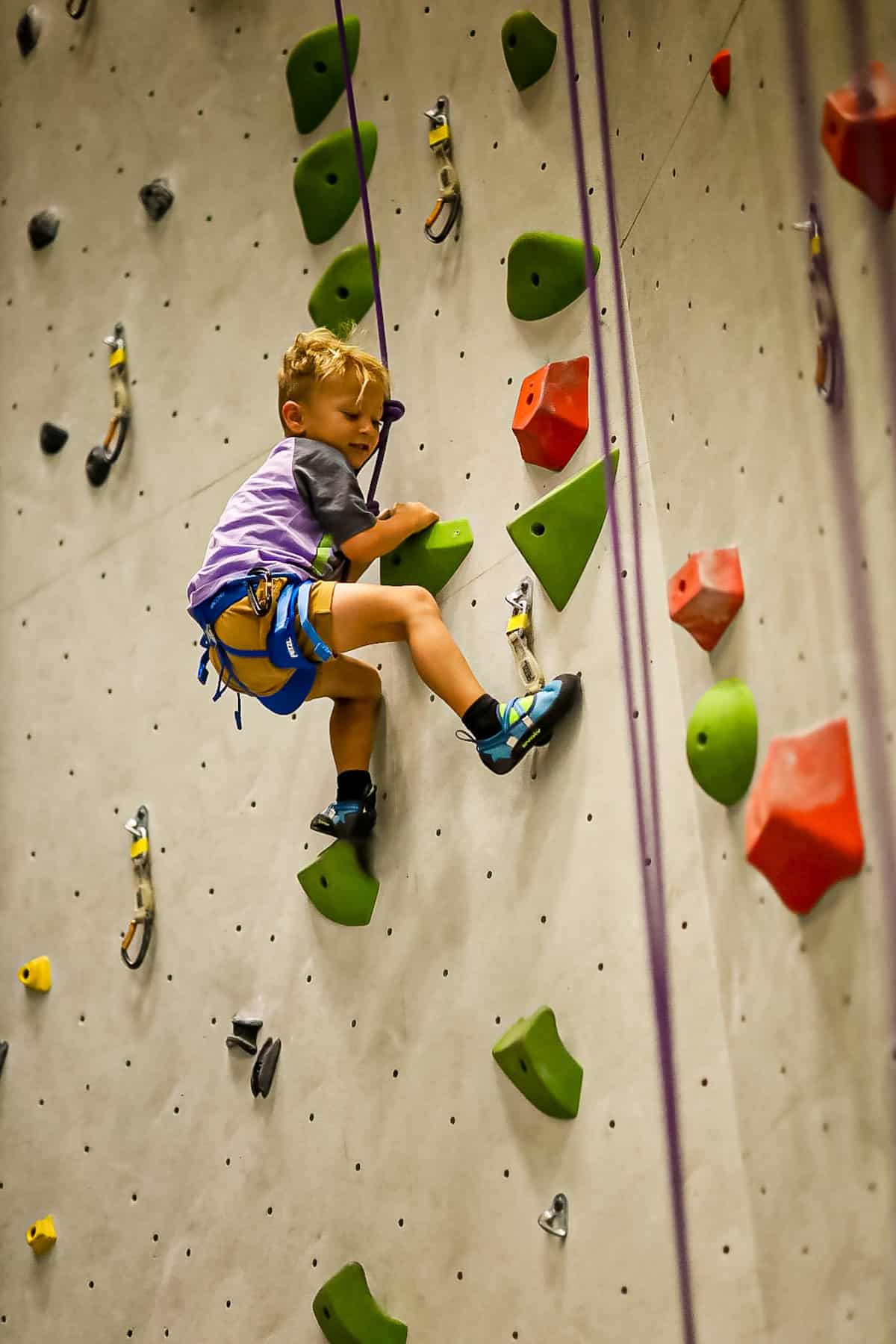
Indoor rock climbing equipment
Depending upon whether you’re bouldering or rope climbing, the equipment needs will be slightly different. For bouldering, a pair of climbing shoes is helpful, although not necessary, until your child shows a real interest in the sport. Climbing shoes have rubber soles for extra grip. Some gyms offer a shoe rental option until you’re ready to buy them.
For rope climbing, in addition to climbing shoes, you’ll need a helmet and harness. A helmet should be properly fitted and rest level on a climber’s head, with little to no slack on the chin strap, and the “Y” of the strap resting below the climber’s ear. A properly fitted harness has snug leg loops, a snug waistband that sits above the hip bones, all buckles double-backed, and shoulder straps snug against the shoulders. Kids over 48 inches can get by with a waist harness, but kids shorter than 48 inches may be required to wear a full-body harness.
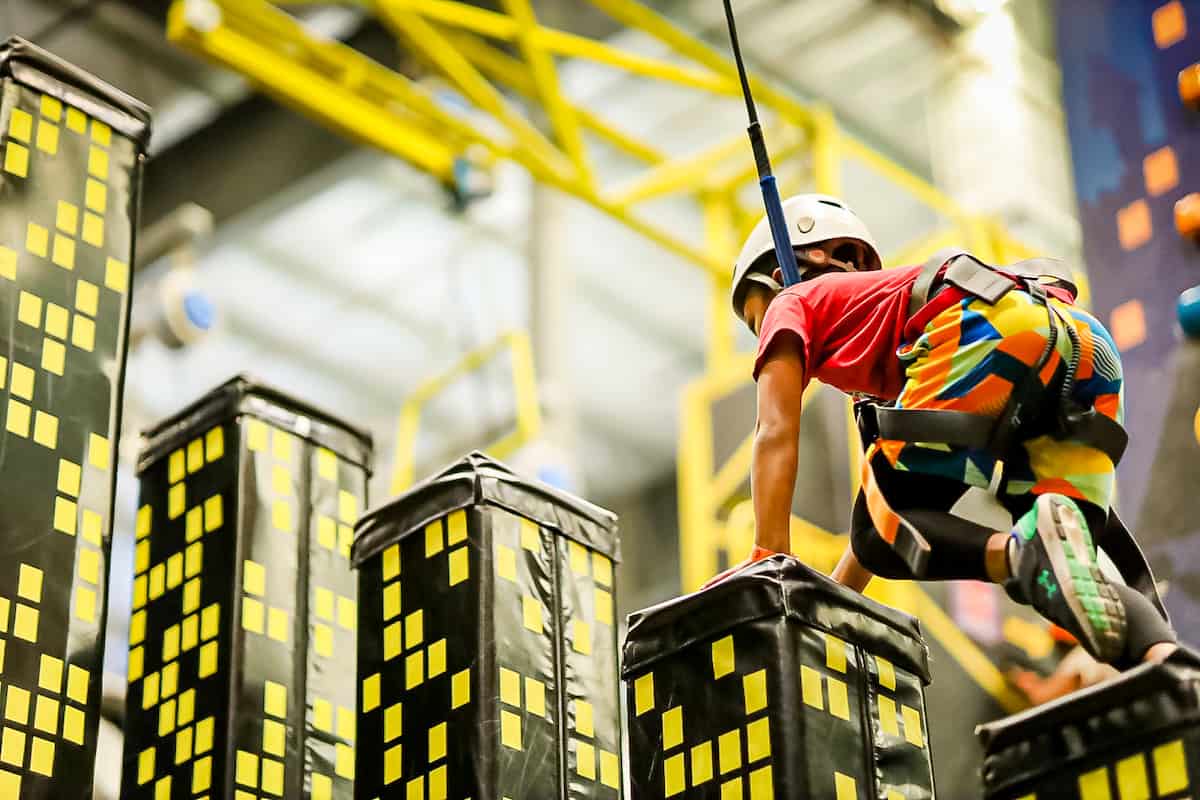
What you need to know to rock climb
Rope climbers will need carabiner clips and knowledge of tying knots. In an intro to climbing session, your instructor will help with the very important work of tying your knots. In our session, we had someone to help us tie a Figure 8 for the main knot and a double fisherman knot for added safety. When auto-belaying, it’s important to attach the carabiner clip to your harness correctly. It’s also a good idea to check and recheck that your carabiner is secure before starting a climb.
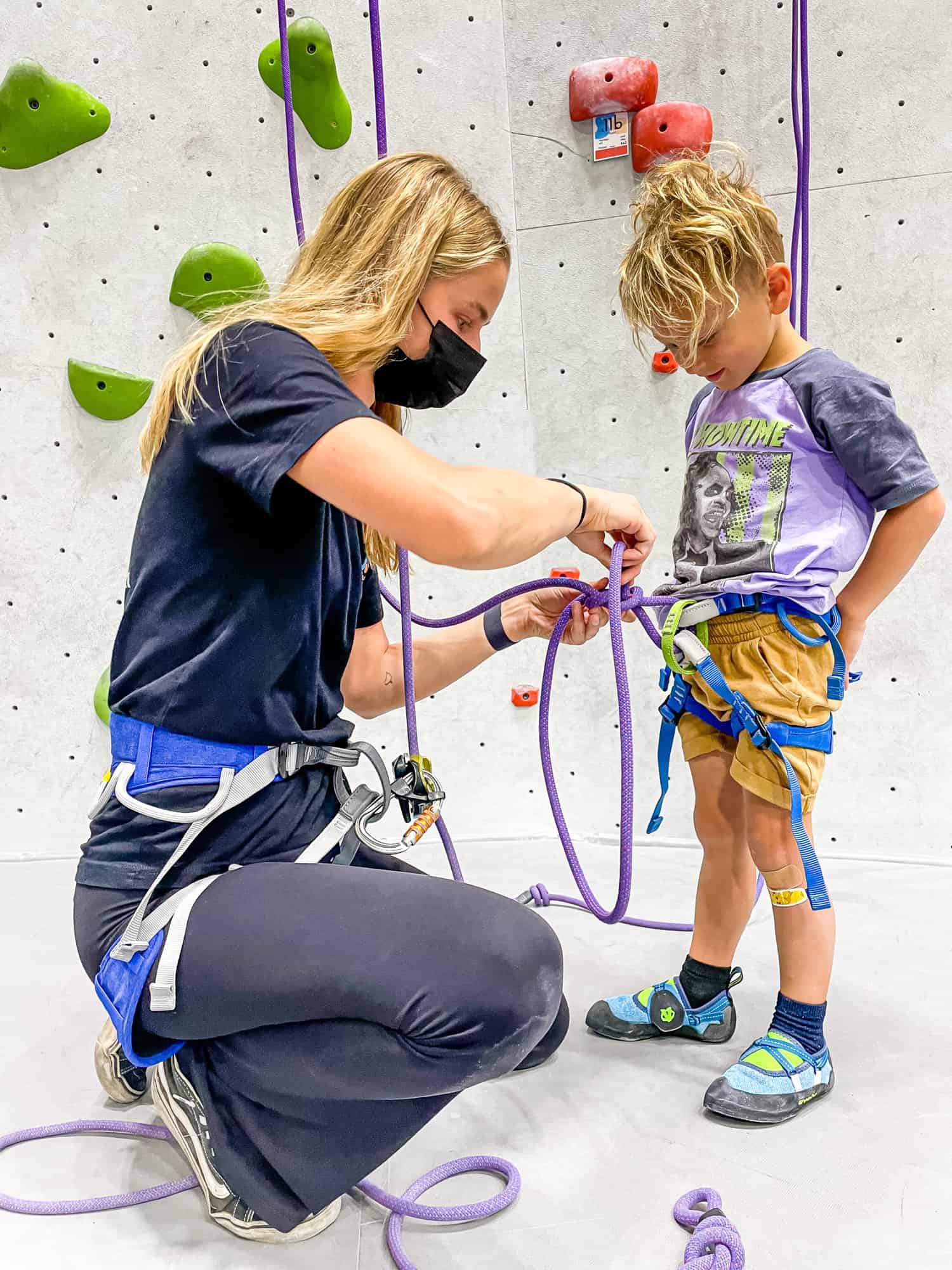
Tackling indoor rock wall climbing routes
When your littles are ready to tackle indoor climbing walls, here are a few pointers to help get you on your way. Many gyms have colorful climbing walls filled with colored grips and footholds. Those colors mean something- they differentiate routes along the wall, oftentimes by the level of difficulty. Beginner climbers typically follow one color up and down the wall.
As your climber acclimates and their skill level increases, they can attempt “rainbow climbing” which simply means they mix colors along their route. At Sender One, the color-coded routes had fun and fanciful names like Fairy Tears, Newt’s Eyes, the Tortoise, and the English Open. Indoor rock climbing for kids becomes that much more fun with names like these!
Rock climbing walls at indoor gyms are fun to look at. Not only are they colorful, but they have a variety of shapes to simulate the diversity of rock surfaces one might find in nature. These grips, or “holds,” as they are called, have descriptive names like seats, bubbles, lightning bolts, etc. The most common holds kids will use are called “jugs,” but holds like “slopes” are helpful for kids to palm, and “pinchers” can be gripped from the top and bottom.
Pro tip from a Sender One instructor: Get your feet nice and high! It’s not a new climber’s first instinct to move their feet to help them find a handhold to continue their climb. By moving your feet around and getting them nice and high, it opens more holds for them to reach.
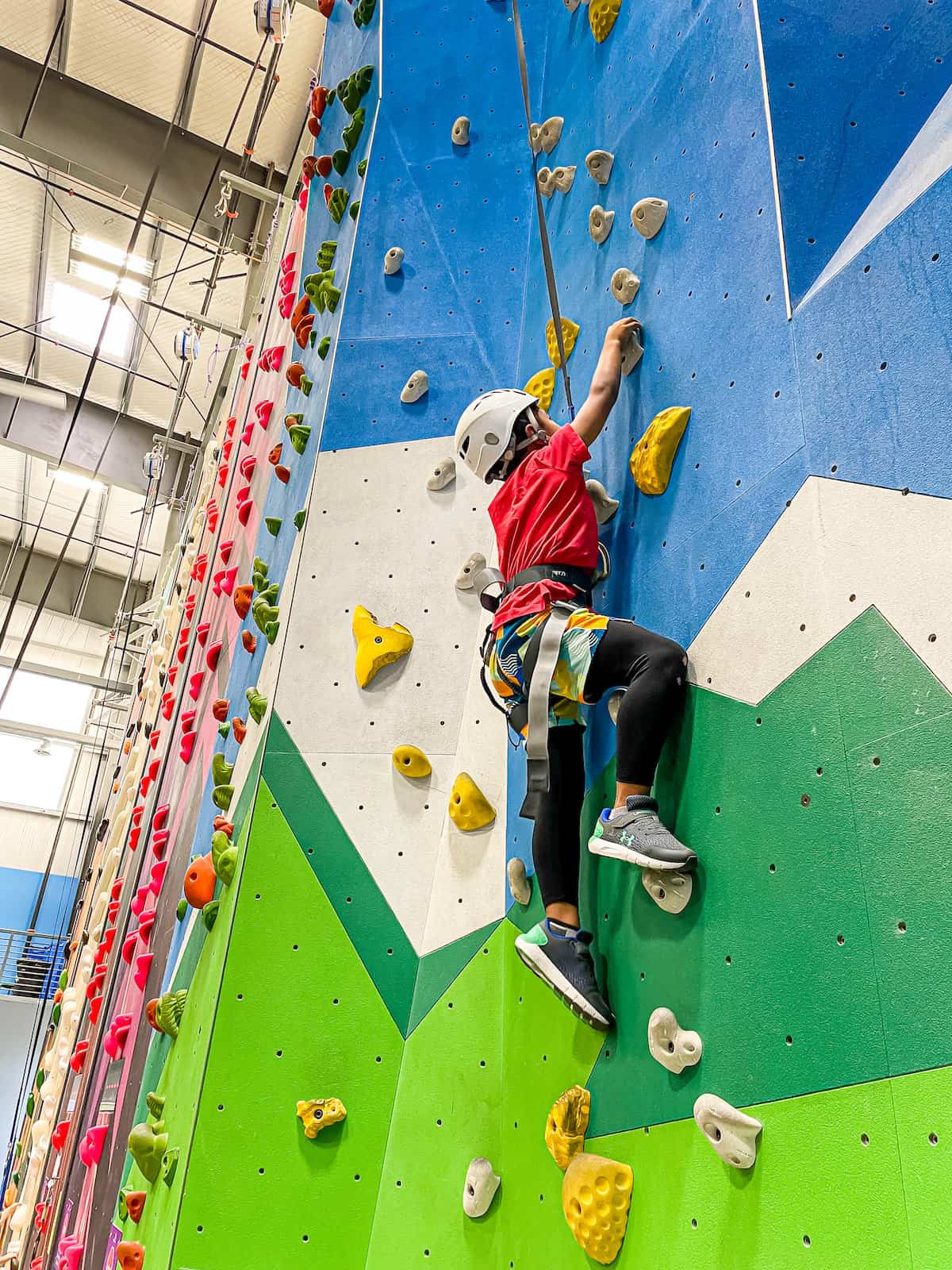
Indoor climbing walls & kid safety
Indoor rock climbing for kids has risks, but when you exercise caution and good judgment, it can be a very safe sport. A few safety tips to keep in mind have everything to do with knowing how to land and fall.
- To fall on your back, stay relaxed, bend your knees and arms, tuck your arms in, and roll back.
- To fall on your side, look at your landing zone, bend your knees and arms, tuck your arms in, and fall, letting the pads do the work.
- Similar to learning how to fall from a bike, never use your hands to break your fall.
- Like in gymnastics, when you stick a landing, bend your knees but don’t lock them.
Be aware of your surroundings and always follow directions! When indoor rope climbing, it’s important to know how to descend safely. Once your little one climbs as far as they feel comfortable, encourage them to sit back like they’re in a chair and relax as they make their way back to the ground. To keep them from twisting their rope on the way down, instruct them to stay focused on the wall until their two feet are safely touching the floor.
Climbing gyms
Climbing gyms are a perfect place to get started when your child is first interested in learning how to rock climb. For one, climbing gyms provide a supportive environment filled with instructors and experienced climbers that are willing to help with advice and tips. They also offer gear rentals which makes it a low-cost commitment to try out while you decide if this is something you’d like to continue before investing in gear. If you love rock climbing, a gym membership would be a great gift for your child.
Check out the Indoor Climbing website to find a climbing gym close to you. Many indoor climbing gyms offer youth programs and classes specifically for kids, with professional adult supervision. There may even be youth discounts for young climbers. They may also offer day camps, summer camps, birthday parties, open gym time, kids’ activities, games, private lessons, school programs, themed day events, competitive youth teams, group events, and other ways to make climbing fun and social for kids.
Earn a merit patch for indoor rock climbing
Are you excited to try indoor rock climbing with your kids? Want to earn a fun merit patch for trying this fun new sport?
Wonder Club Explorers is an independent scouting program for kids and features 18 patches in 9 different fields of learning. During our indoor rock-climbing adventure, my son earned his Wonder Club Explorer Obstacle Ninja and Maze Master Merit Patches. Indoor rock climbing, in and of itself, was a vertical obstacle challenge, but maneuvering around the holds was a three-dimensional maze to be solved. This activity proved to be a two-for-one as rock climbing satisfied both patches in one outing.
Check out our website to learn more about Wonder Club Explorers.
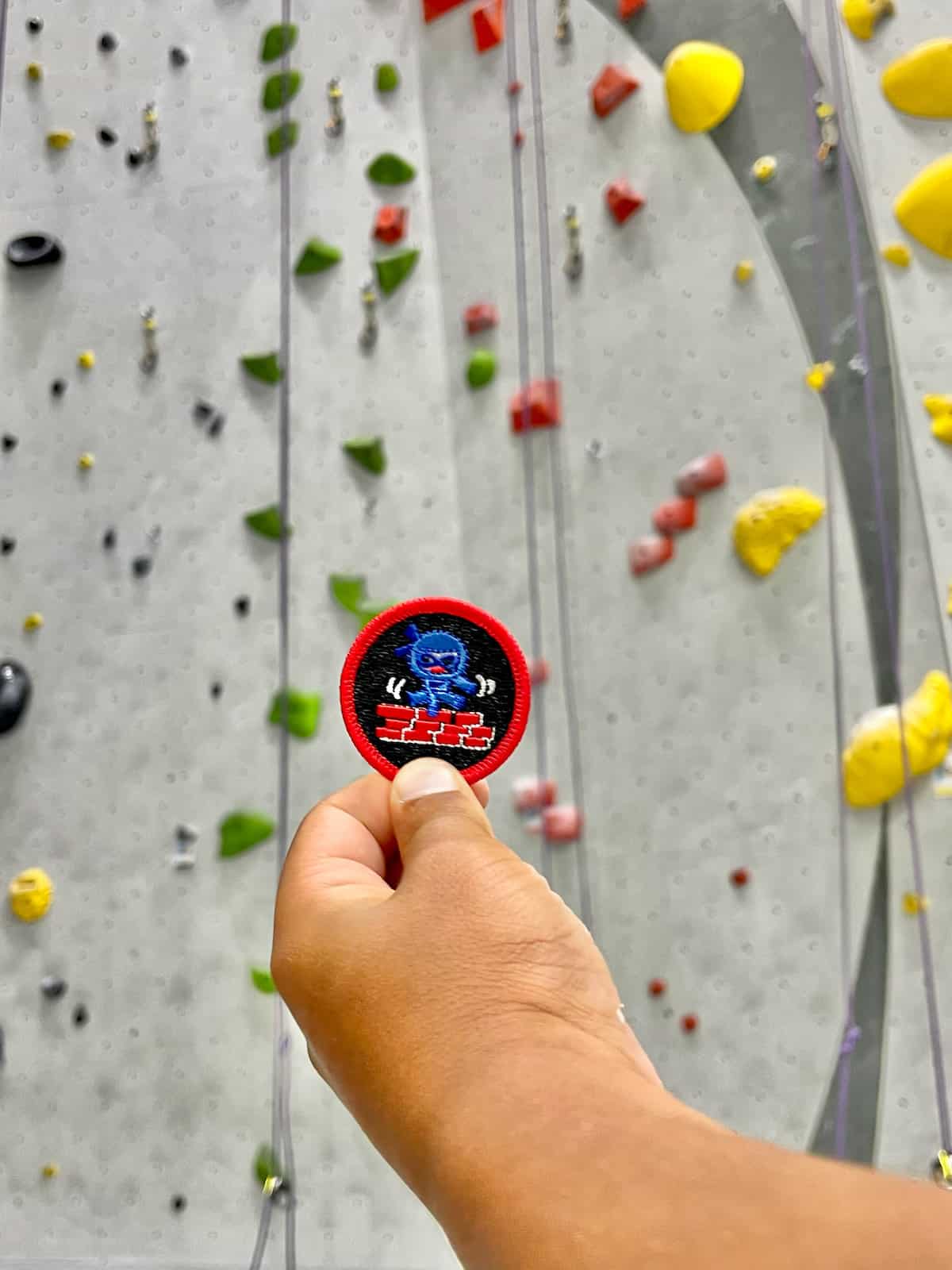
Indoor rock climbing basics for kids
Indoor rock climbing for kids is an absolute blast! My son had so much fun and I loved watching him gain confidence as he learned a new skill. Before we sign off, we want to make sure you’ve got the lingo of a real climber. As you initiate the climb, your climbing partner will say “On Belay” to which you respond, “Belay On.” “Climb on,” says your partner, and off you go! Whether you’re climbing the walls at a gym or scaling your own climbing wall at home, we hope you have fun! Until next time!
Special thanks to Sender One for showing us the ropes of indoor rock climbing!
Additional resources
If you’re interested in learning more about rock climbing and other related activities, be sure to check out a few more of these great posts:
- How to Get Started Rock Climbing with Kids (indoor and outdoor)
- Best Experience Gifts for Kids
- Letting your Kids Take Healthy Risks Through Adventures
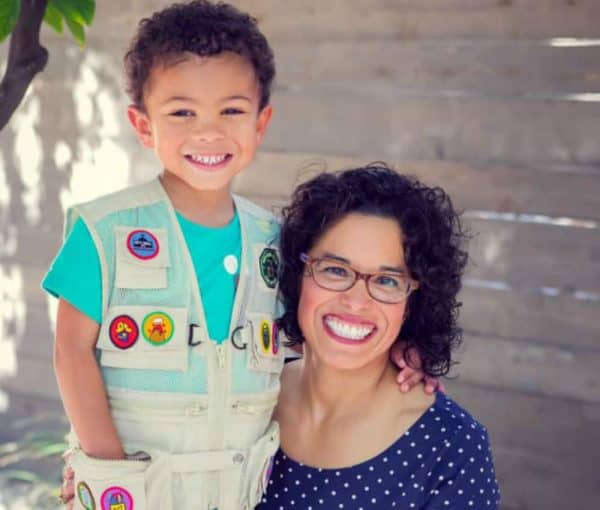
About the author
Michelle spends her days working on projects to improve the quality of life for the citizens of her community and her nights reading books to her 6-year-old about every kind of dinosaur there ever was (there are 900 validated species, in case you’re wondering). Together with her son, Michelle created Wonder Club Explorers, a company to inspire wonder and curiosity in kids. She carves out time for herself on the weekends as an early morning exerciser and metalsmith of fine jewelry. Michelle is also the co-host of the Run Wild My Child podcast. She resides in Altadena with her husband and son amongst California oak trees and a stone’s throw from the San Gabriel Mountains.
You can find Michelle online in the following locations:
Instagram: @wonderclubexplorers
Website: www.wonderclubexplorers.co
RWMC posts: Michelle Garrett

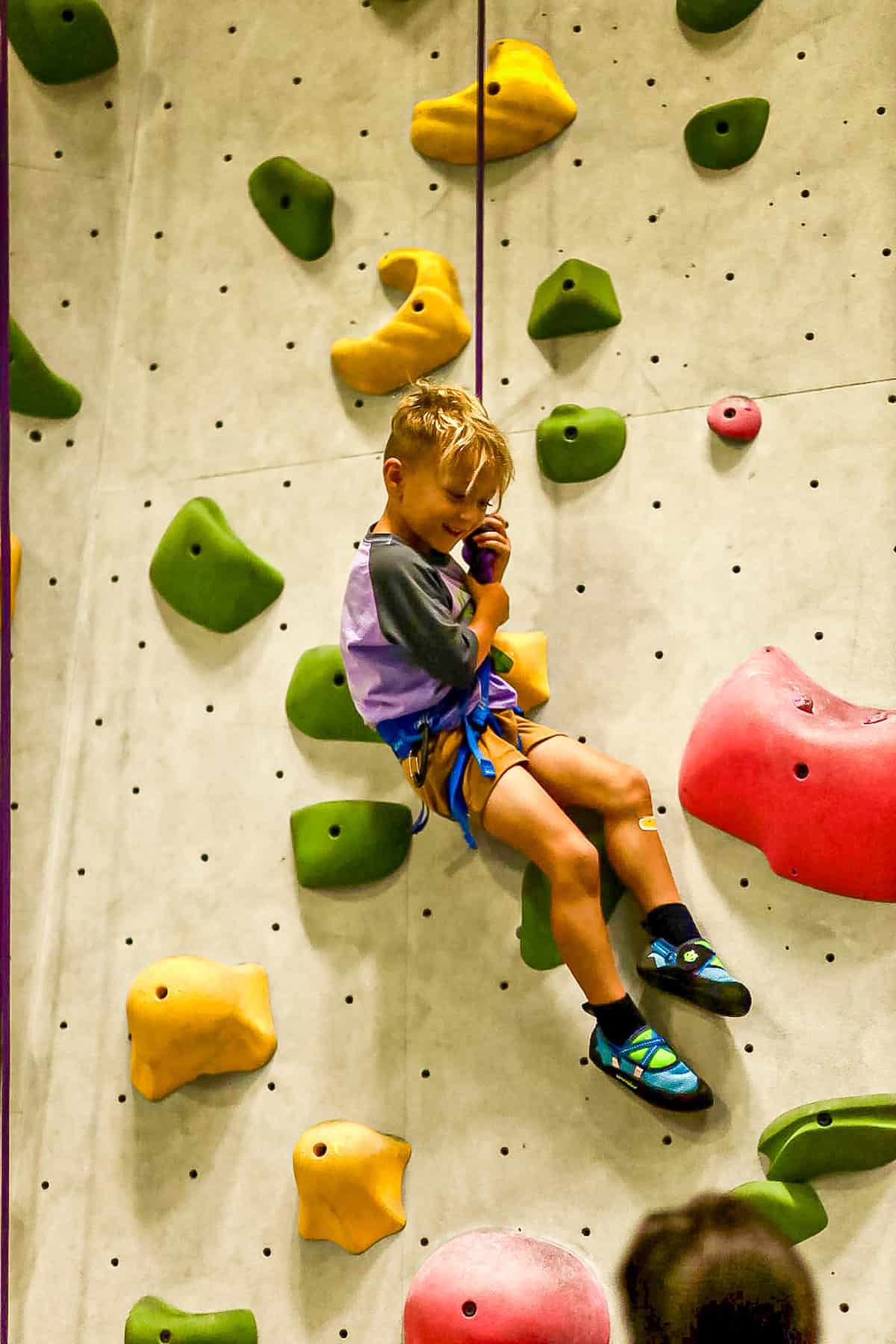







2 comments